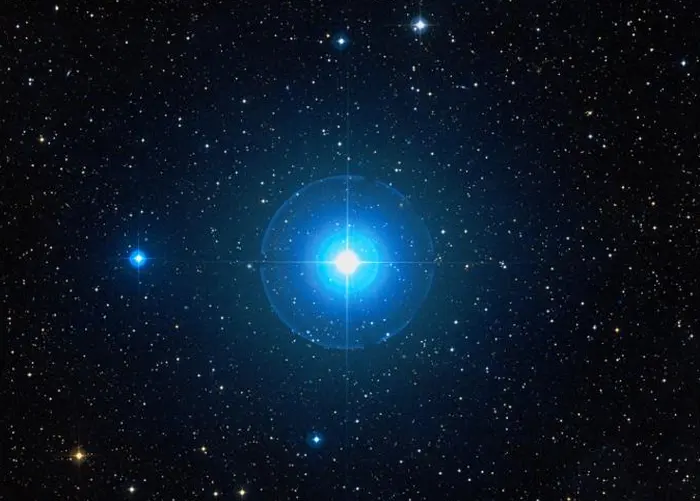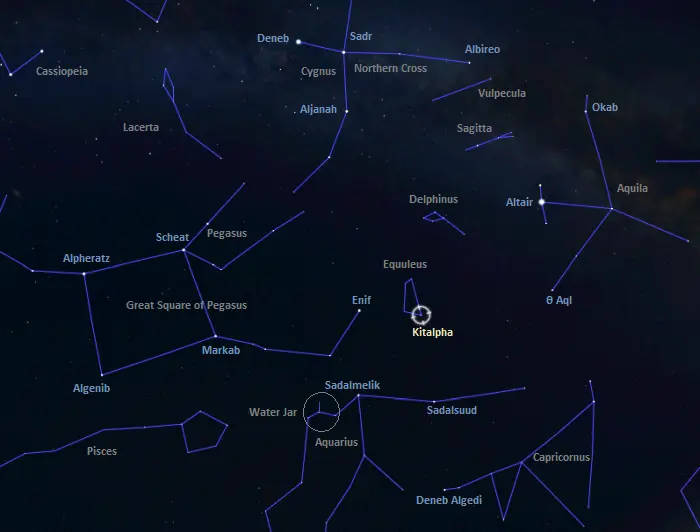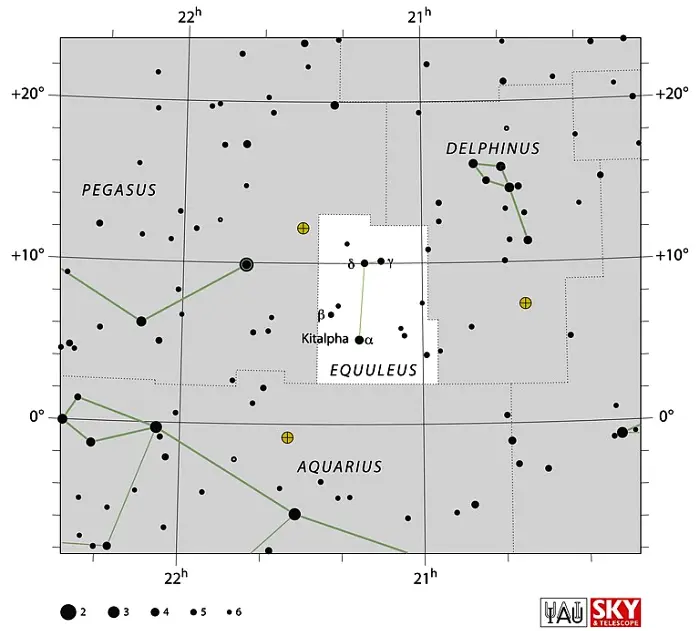Kitalpha, Alpha Equulei (α Equ), is a yellow giant star located 190 light-years away in the constellation Equuleus (the Little Horse). The evolved star is the primary component in a binary system. With an apparent magnitude of 3.919, it is the brightest star in Equuleus.
Star system
Alpha Equulei is a spectroscopic binary star composed of a yellow giant of the spectral type G7III and a white main sequence star with the stellar classification kA3hA4mA9.
The two components orbit each other with a period of 98.8098 days. They appear as a single star to the unaided eye and are so close together that they cannot be resolved even in large telescopes. The only evidence of binarity is in the star system’s spectrum. The light emitted from each component periodically shifts towards the blue and then towards the red as the component moves towards us and then away from us as it orbits around the system’s common centre of mass.
The primary component, Alpha Equulei A, is formally known as Kitalpha. The giant star has 2.3 times the Sun’s mass and a radius 9.2 times solar. With an effective temperature of 5,100 K, it is 52.5 times more luminous than the Sun. It spins at 20 km/s.

Kitalpha (Alpha Equulei), image: Wikisky (DSS2)
The companion is still fusing hydrogen on the main sequence. The A-type dwarf has a mass of 2 solar masses and a radius 2.6 times that of the Sun. It shines with 26.3 solar luminosities with a surface temperature of 8,150 K. The star has an estimated age of 740 million years. It was previously classified as a yellow subgiant of the spectral type G6IV.
Alpha Equulei B is classified as an Am star. Am stars are chemically peculiar stars of the spectral type A with strong lines of metals such as strontium, zinc, barium and zirconium and an underabundance of others like scandium and calcium. The spectral class kA3hA4mA9 indicates that the star is type A3 based on the Calcium k line, A4 when judged by its hydrogen lines, and A9 based on its lines of heavy metals. Alpha Equulei B was previously classified as a hotter main sequence star of the spectral type B9.5V.
Name
The name Kitalpha (pronunciation: /kɪˈtælfə/) comes from the Arabic phrase qiṭ‘a(t) al-faras, meaning “a piece of the horse.” The name was historically also spelled Kitalphar or Kitel Phard.
The International Astronomical Union’s (IAU) Working Group on Star Names (WGSN) approved the name Kitalpha on August 21, 2016. The name formally applies only to the primary component, Alpha Equulei A.
In traditional Chinese astronomy, Kitalpha was known as 虛宿二 (Xū Sù èr), the Second Star of Emptiness. It formed the Emptiness (or Ruins) asterism with Sadalsuud (Beta Aquarii), the brightest star in the constellation Aquarius. The asterism was part of the larger Ruins mansion, one of the northern mansions of the Black Tortoise.
Location
Kitalpha lies in the faint constellation Equuleus, but it can be found using the brighter stars that appear in the same region of the sky. The star appears near Enif, the brightest star in the constellation Pegasus. It can be found about a third of the way from the yellow supergiant Sadalmelik, the second brightest star in Aquarius (the Water Bearer), to the bright Altair in Aquila (the Eagle).
The constellation figure of Equuleus appears in the region between Sadalsuud and Sadalmelik, the brightest stars in Aquarius, and the small but distinctive figure of Delphinus (the Dolphin).
Sadalmelik is the brightest star near the Water Jar of Aquarius. It forms the Lightning Bolt asterism with the fellow supergiants Enif and Sadalsuud and the giant Deneb Algedi, the brightest star in Capricornus.

The location of Kitalpha (Alpha Equulei), image: Stellarium
Constellation
Kitalpha is located in the northern constellation of Equuleus. Representing the celestial Little Horse or Foal, Equuleus is the second smallest constellation in the sky, after Crux (the Southern Cross). It occupies an area of only 72 square degrees between Pegasus, Delphinus, and Aquarius.
With no stars brighter than magnitude 3.0, Equuleus is one of the faintest northern constellations. It is one of the ancient Greek constellations. It was created by the Greek astronomer Hipparchus and catalogued by Claudius Ptolemy of Alexandria in the 2nd century CE. Ptolemy only listed four stars in the constellation, calling the star pattern “the front part of the horse.”
Unlike the brighter and larger Pegasus, Equuleus is depicted only as a horse’s head. In Greek mythology, the constellation is associated with the foal Celeris (“swiftness”), the offspring or sibling of Pegasus, the winged horse.

Equuleus constellation map, image credit: IAU and Sky & Telescope magazine (Roger Sinnott & Rick Fienberg) (CC BY 3.0)
Other than Kitalpha, notable stars in Equuleus include the spectroscopic binary stars Delta Equulei and HD 202951, the rapidly oscillating Ap star Gamma Equulei, the orange giant 3 Equulei, the red giant 9 Equulei, and the yellow subgiant HD 200964, which hosts a pair of orbiting planets.
Equuleus does not contain any bright deep sky objects. It is home to several relatively faint galaxies, including the spiral galaxies NGC 7015, NGC 7046, and NGC 7040.
The best time of the year to observe the stars and deep sky objects in Equuleus is during the month of September, when the constellation appears higher above the horizon in the early evening. While the Little Horse is not an equatorial constellation, it lies close enough to the celestial equator to be visible from virtually anywhere on Earth for at least part of the year. The entire constellation is visible from locations north of the latitude 80° S.
The 10 brightest stars in Equuleus are Kitalpha (Alpha Equ, mag. 3.919), Delta Equulei (mag. 4.47), Gamma Equulei (mag. 4.7), Beta Equulei (mag. 5.16), Epsilon Equulei (mag. 5.23), 3 Equulei (mag. 5.593), 9 Equulei (mag. 5.798), 4 Equulei (mag. 5.94), HD 202951 (mag. 5.97), and HD 199942 (mag. 5.98).
Kitalpha – Alpha Equulei
| Spectral class | G7III + kA3hA4mA9 |
| U-B colour index | +0.284 |
| B-V colour index | +0.529 |
| Apparent magnitude | 3.919 (4.49/4.96) |
| Absolute magnitude | +0.17 (0.71 + 1.18) |
| Distance | 190 ± 2 light-years (58.3 ± 0.7 parsecs) |
| Parallax | 17.1985 ± 0.2428 mas |
| Radial velocity | −16.26 ± 0.06 km/s |
| Proper motion | RA: +49.747 ± 0.204 mas/yr |
| Dec.: −89.846 ± 0.182 mas/yr | |
| Constellation | Equuleus |
| Right ascension | 21h 15m 49.4371672506s |
| Declination | +05° 14′ 52.411028661″ |
| Names and designations | Kitalpha, Alpha Equulei, α Equulei, α Equ, 8 Equulei, HD 202447, HD 202448, HR 8131, HIP 104987, SAO 126662, BD +04 4635, FK5 800, GC 29735, GCRV 13363, AG+05 3105, PPM 171503, PLX 5115, ROT 3097, PMC 90-93 561, TD1 27865, WRH 35, 2E 4458, 2E 2113.3+0502, N30 4698, TIC 387501663, GSC 00536-02354, JP11 3326, UBV 18375, UBV M 25570, WEB 19079, IRAS 21133+0502, 2MASS J21154942+0514521, Gaia DR2 1732693474833048192, Gaia DR3 1732693474833518720, CCDM J21158+0515AB, IDS 21108+0450 AB, WDS J21158+0515AB |
Alpha Equulei A
| Mass | 2.3 M☉ |
| Luminosity | 52.5 L☉ |
| Radius | 9.2 R☉ |
| Temperature | 5,100 K |
| Rotational velocity | 20.0 km/s |
Alpha Equulei B
| Mass | 2.0 M☉ |
| Luminosity | 26.3 L☉ |
| Radius | 2.6 R☉ |
| Temperature | 8,150 K |
| Age | 740 million years |